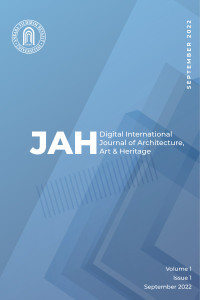Urban and Spatial View of Gated Communities as Transformation Products: An Experimental Study
Gated community, Social sustainability, Urban space
Urban and Spatial View of Gated Communities as Transformation Products: An Experimental Study
___
- Adorno T. W. (2004). The Culture Industry. Routledge Classics, New York.
- Altman, I., (1993). Homes, Housing, and the 21th Century: Prospects and Challenges, The Meaning and Use of Housing, International Perspectives, Approaches and Their Applications. Ashgate, England.
- Altman, I., Low, S. M. (1992). Place Attachment. New York & London: Plenum
- Alver,K. (2009). Steril Hayatlar. Hece Yayınları, İstanbul.
- Ayata, S. (2003). Yeni orta sınıf ve uydu kent yaşamı, içinde D. Kandiyoti ve A. Saktanber (der.), Kültür Fragmanları: Türkiye’de Gündelik Hayat (pp. 37-56). İstanbul: Metis.
- Bal, E., Altun, D.A. (2009). Gated Communıtıes in Istanbul and Izmır in The Context of Investor Fırm’s Qualıtıes. Deü Mühendislik Fakültesi Mühendislik Bilimleri Dergisi, 11(32), 1-9.
- Bassett, K. (1980). Housing and Residentual Structure-Alternative Approaches. Routledge and Kegan Paul Ltd, London.
- Baudrillard, J. (2004). Tüketim Toplumu. Ayrıntı Yayınları, İstanbul.
- Blakely E. J. & Snyder M. G. (1997). Fortress America. Gated Communities in the United States. Brookings Institution Press, Washington, D.C.
- Davis, M. (2007). Gecekondu Gezegeni, Çev: Güral Koca. Metis Yayınları, İstanbul.
- Demirci, M. (2004). Kent Planlamada Uygulama Anlayışına Eleştirel Bir Yaklaşım: Dikmen Vadisi Örneği [Doktora Tezi, Ankara Üniversitesi] Yök Tez Merkezi.
- Dener, A., (1994). Sosyal ve Mekansal Değişmenin Etkileşimi [Doktora Tezi, İ.T.U.] Yök Tez Merkezi.
- Erman, T. (2012). Kent, Konut Ve Taşıdığı Anlamlar: Bağlamlandırılmış (‘Contextualızed’) Bir Yaklaşım, Dosya 20, TMMOB Mimarlar Odası Ankara Şubesi, 6-12.
- Foucault, M. (2000). Hapishanenin Doğuşu. İmge Kitapevi, Ankara.
- Işık, O. & Pınarcıoğlu, M. (2001). Nöbetleşe Yoksulluk Sultanbeyli Örneği. İletişim Yayınları, İstanbul.
- İncedayı, D. (2003). Barınmanın Değil, Yaşama Biçiminin Birimi Olarak Konut. Mimarist Üç Aylık Mimarlık Kültürü Dergisi, 3(7), 81-85.
- Kandiyoti, D. (2005). Kültür Fragmanları Türkiye’de Gündelik Hayat. Metis Yayıncılık, İstanbul.
- Lefevbre, H. (2007). Modern Dünyada Gündelik Hayat. Metis Yayınları, İstanbul.
- Low S. (2003) Behind the Gates: Life, Security and the Pursuit of Happiness in Fortress America. Routledge: New York ve London.
- Ritzer G. (2000). Büyüsü Bozulmuş Dünyayı Büyülemek, Çev.: Ş. S. Kaya. Ayrıntı Yayınları, İstanbul.
- Sennet, R. (2002). Kamusal İnsanın Çöküşü. Ayrıntı Yayınları, İstanbul.
- Thorns, D. C., (2004) Kentlerin Dönüşümü, Kent Teorisi ve Kentsel Yaşam. CSA Global Yayın Ajansı, İstanbul.
- URL-1. (No Date). Retrieved February 15, 2023, from https://earth.google.com/web/search/park+vadi+evleri/@39.88056052,32.85391253,1058.59330639a,8111.84011047d,35y,-0h,0t,0r/data=CigiJgokCYdVCpW-hDRAEYdVCpW-hDTAGe_7YrKOtDJAIb9OyiNR3lTA
- URL-2. (No Date). Retrieved February 15, 2023, from Ankara Büyükşehir Belediyesi, Tarihsel Gelişim Planlama Süreci, www.ankara.bel.tr/AbbSayfalari/ABB_Nazim_Plani/rapor/2-tarihce.pdf.
- URL-3. (No Date). Retrieved February 15, 2023, from http://www.hgmimarlik.com/projects/park-vadi-evleri
- Ünlü, A. (1998). Çevresel Tasarımda İlk Kavramlar. İTÜ Mimarlık, İstanbul.
- Başlangıç: 2022
- Yayıncı: Ankara Yıldırım Beyazıt Üniversitesi
Teknolojik Yenilikler Doğrultusunda Müzelerde Sergileme Yöntemlerinin Değişimi
SYMBOLIC DESIGN AND KITSCH PRODUCTION IN ARCHITECTURE IN A HYPERREAL POSTMODERN CONTEXT
Urban and Spatial View of Gated Communities as Transformation Products: An Experimental Study
Tuğçe ÇELİK, Zeliha ŞAHİN ÇAĞLI
USAGE OF TILE IN THE ISTANBUL BUILDING FACADES OF THE LATE OTTOMAN-EARLY REPUBLICAN PERIOD
Sivas Kentindeki Anadolu Selçuklu Medreselerinin Bir Yöntem Denemesi ile İrdelenmesi
